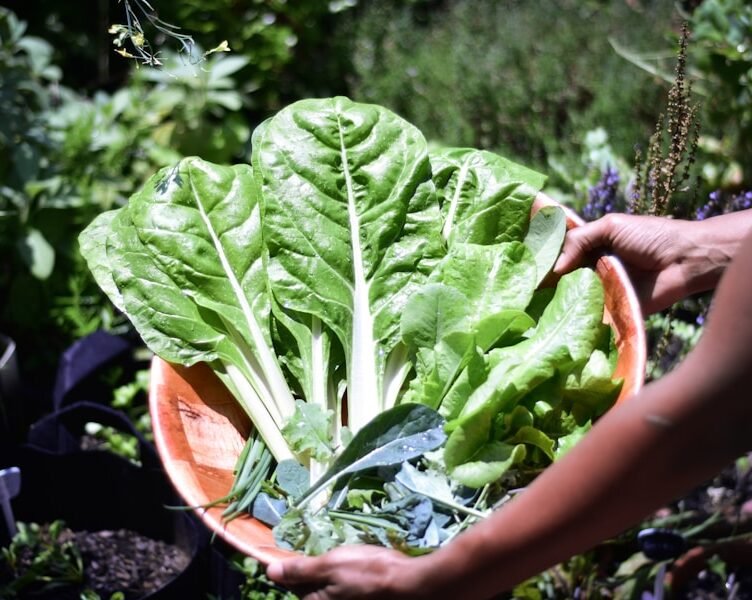Growing vegetables indoors without natural light requires careful selection of varieties that thrive in low-light conditions. Leafy greens, such as spinach, lettuce, and kale, are ideal for indoor cultivation as they require minimal sunlight to grow. Herbs like parsley, cilantro, and chives also perform well in low-light environments, making them suitable for indoor gardens.
Additionally, root vegetables like carrots and radishes can be grown indoors, provided they have sufficient space to develop underground. In contrast, vegetables that demand high levels of sunlight, such as tomatoes, peppers, and cucumbers, may not be the best choice for indoor growing without natural light. These vegetables typically require at least 6-8 hours of direct sunlight per day to thrive, which can be challenging to achieve indoors.
When selecting vegetables for indoor growing, it is essential to consider the available space and the amount of light the indoor garden will receive. By choosing varieties that are well-suited for low-light conditions, you can create a thriving indoor garden that will provide fresh, homegrown produce year-round.
Key Takeaways
- Choose vegetables that thrive in low light conditions, such as lettuce, spinach, and kale, for indoor growing without natural light.
- Use LED grow lights to provide the necessary light spectrum for indoor vegetable gardening, and adjust the distance and duration of light exposure based on the specific needs of each plant.
- Maintain a consistent temperature, humidity, and air circulation to create an ideal growing environment for indoor vegetables, and consider using a timer for the grow lights to mimic natural daylight cycles.
- Water indoor vegetable plants carefully to avoid overwatering or underwatering, and use a balanced fertilizer to provide essential nutrients for healthy growth.
- Keep an eye out for common pests and diseases in indoor vegetable gardens, and use natural remedies or organic pesticides to manage issues without harming the plants or the environment.
Understanding Artificial Lighting for Indoor Vegetable Gardening
Choosing the Right Artificial Lighting
When it comes to choosing the right artificial lighting for indoor vegetable gardening, there are a few key factors to consider. LED grow lights are a popular choice for indoor vegetable gardening as they are energy-efficient and provide a full spectrum of light that is essential for plant growth. Fluorescent grow lights are also a good option for indoor gardening, as they are affordable and produce a balanced spectrum of light that is suitable for most vegetables.
Other Lighting Options
Additionally, high-intensity discharge (HID) grow lights can be used for indoor vegetable gardening, although they tend to be more expensive and produce more heat than other types of lighting.
Light Intensity and Duration
In addition to choosing the right type of artificial lighting, it’s important to consider the intensity and duration of light exposure for your indoor vegetable plants. Most vegetables require at least 12-16 hours of light per day in order to grow and develop properly. By understanding the role of artificial lighting in indoor vegetable gardening and selecting the right type of lighting for your indoor garden, you can create an optimal growing environment for your vegetables to thrive.
Creating the Ideal Growing Environment for Indoor Vegetables
When it comes to growing vegetables indoors without natural light, creating the ideal growing environment is essential for the success of your indoor garden. In addition to providing the right type of artificial lighting, there are several other factors to consider when creating an optimal growing environment for indoor vegetables. One important factor to consider is temperature and humidity levels in your indoor garden.
Most vegetables thrive in temperatures between 65-75°F (18-24°C) and require moderate humidity levels to grow and develop properly. It’s important to monitor and regulate temperature and humidity levels in your indoor garden to ensure that your vegetables have the ideal growing conditions. Another key factor in creating the ideal growing environment for indoor vegetables is air circulation.
Good air circulation is essential for preventing mold and mildew growth, as well as ensuring that carbon dioxide is distributed evenly throughout your indoor garden. Using fans or opening windows can help improve air circulation in your indoor garden and create a healthier growing environment for your vegetables. In addition to temperature, humidity, and air circulation, it’s important to consider the soil and containers you use for indoor vegetable gardening.
Using a high-quality potting mix and well-draining containers will help ensure that your vegetables have the right growing medium to thrive indoors. By creating the ideal growing environment for your indoor vegetables, you can set yourself up for success and enjoy a bountiful harvest of homegrown produce.
Tips for Watering and Fertilizing Indoor Vegetable Plants
| Vegetable | Light Requirements | Optimal Temperature | Watering Needs | Growth Time |
|---|---|---|---|---|
| Lettuce | 12-16 hours of artificial light | 60-70°F | Regular, keep soil moist | 30-45 days |
| Spinach | 12-14 hours of artificial light | 50-75°F | Regular, keep soil moist | 40-50 days |
| Tomatoes | 14-18 hours of artificial light | 65-85°F | Regular, keep soil consistently moist | 60-85 days |
| Carrots | 14-16 hours of artificial light | 60-70°F | Regular, keep soil moist | 70-80 days |
Proper watering and fertilizing are essential for the health and growth of indoor vegetable plants. When it comes to watering indoor vegetables, it’s important to strike a balance between providing enough moisture for your plants without overwatering them. Overwatering can lead to root rot and other issues, while underwatering can cause plants to wilt and become stressed.
One tip for watering indoor vegetable plants is to water them thoroughly but infrequently. This means allowing the soil to dry out slightly between waterings, then thoroughly saturating the soil when you do water. This encourages deep root growth and helps prevent issues like root rot and mold.
In addition to proper watering, fertilizing is also important for indoor vegetable plants. Since indoor plants are confined to containers, they rely on you to provide them with the nutrients they need to grow and thrive. Using a balanced fertilizer specifically formulated for vegetables can help ensure that your plants have the nutrients they need to produce healthy foliage and bountiful harvests.
When fertilizing indoor vegetable plants, it’s important to follow the instructions on the fertilizer package and avoid over-fertilizing, which can lead to nutrient imbalances and other issues. Additionally, using organic fertilizers can help promote healthy soil and microbial activity in your indoor garden. By following these tips for watering and fertilizing indoor vegetable plants, you can help ensure that your plants have the nutrients they need to thrive and produce a bountiful harvest.
Managing Pests and Diseases in Indoor Vegetable Gardens
Pests and diseases can pose a threat to indoor vegetable gardens, so it’s important to be proactive in managing these issues in order to protect your plants. One way to prevent pests and diseases in your indoor garden is by practicing good sanitation. This includes regularly cleaning and disinfecting your gardening tools, as well as removing any dead or diseased plant material from your garden.
Another effective way to manage pests and diseases in indoor vegetable gardens is by using natural pest control methods such as introducing beneficial insects or using organic pest control products. For example, ladybugs can help control aphid populations, while neem oil can be used to deter pests like spider mites and whiteflies. In addition to preventing pests and diseases, it’s important to monitor your plants regularly for any signs of trouble.
Early detection of pests or diseases can help prevent them from spreading and causing serious damage to your plants. By being proactive in managing pests and diseases in your indoor vegetable garden, you can help ensure that your plants remain healthy and productive.
Harvesting and Enjoying the Fruits of Your Indoor Garden
Timing is Everything
When it comes time to harvest your indoor vegetables, it’s crucial to do so at the right time to maximize flavor and nutritional content. Most vegetables are best harvested when they are at peak ripeness, which can vary depending on the type of vegetable.
Harvesting Techniques
When harvesting leafy greens like lettuce or spinach, it’s best to pick individual leaves as needed rather than harvesting the entire plant at once. This allows the plant to continue producing new leaves over an extended period of time. For root vegetables like carrots or radishes, it’s important to harvest them when they have reached their full size but before they become woody or overgrown.
Enjoying the Fruits of Your Labor
Once you’ve harvested your indoor vegetables, it’s time to enjoy them! Freshly harvested vegetables can be used in a variety of delicious recipes, from salads and stir-fries to soups and smoothies. By harvesting and enjoying the fruits of your indoor garden, you can savor the flavor of homegrown produce and reap the rewards of your hard work.
Troubleshooting Common Issues in Indoor Vegetable Gardening
Despite your best efforts, you may encounter some common issues when growing vegetables indoors without natural light. One common issue is leggy growth, which occurs when plants stretch out in search of more light. To prevent leggy growth, it’s important to provide adequate artificial lighting and ensure that your plants are receiving enough light energy to grow properly.
Another common issue in indoor vegetable gardening is nutrient deficiencies, which can occur when plants are not receiving enough essential nutrients from their growing medium or fertilizer. To prevent nutrient deficiencies, it’s important to use a balanced fertilizer specifically formulated for vegetables and monitor your plants regularly for any signs of nutrient imbalances. In addition to leggy growth and nutrient deficiencies, you may also encounter issues with pests or diseases in your indoor vegetable garden.
By practicing good sanitation, using natural pest control methods, and monitoring your plants regularly, you can help prevent these issues from becoming serious problems in your indoor garden. In conclusion, growing vegetables indoors without natural light is possible with the right knowledge and techniques. By choosing the right vegetables for indoor growing, understanding artificial lighting, creating an ideal growing environment, watering and fertilizing properly, managing pests and diseases, harvesting with care, and troubleshooting common issues, you can create a thriving indoor vegetable garden that provides you with fresh produce year-round.
With dedication and attention to detail, you can enjoy the rewards of homegrown vegetables even without natural sunlight.
FAQs
What are the benefits of growing vegetables indoors without natural light?
Growing vegetables indoors without natural light allows you to have fresh produce year-round, regardless of the weather outside. It also gives you more control over the growing conditions, such as temperature and humidity, and reduces the risk of pests and diseases.
What are the key factors to consider when growing vegetables indoors without natural light?
Key factors to consider when growing vegetables indoors without natural light include choosing the right location for your indoor garden, providing artificial light sources, maintaining proper temperature and humidity levels, and selecting the right containers and soil for your plants.
What are the best vegetables to grow indoors without natural light?
Some of the best vegetables to grow indoors without natural light include leafy greens like lettuce, spinach, and kale, as well as herbs like basil, cilantro, and parsley. These plants require less sunlight and can thrive in indoor growing conditions.
What are the best artificial light sources for growing vegetables indoors?
The best artificial light sources for growing vegetables indoors include full-spectrum LED grow lights, fluorescent grow lights, and high-intensity discharge (HID) grow lights. These lights provide the necessary spectrum of light for plant growth and can be adjusted to meet the specific needs of different vegetables.
How can I ensure proper ventilation for my indoor vegetable garden?
Proper ventilation for an indoor vegetable garden can be achieved by using fans to circulate air, opening windows or using exhaust fans to remove stale air, and avoiding overcrowding plants to allow for adequate air flow. Good ventilation helps prevent mold and mildew and ensures healthy plant growth.






